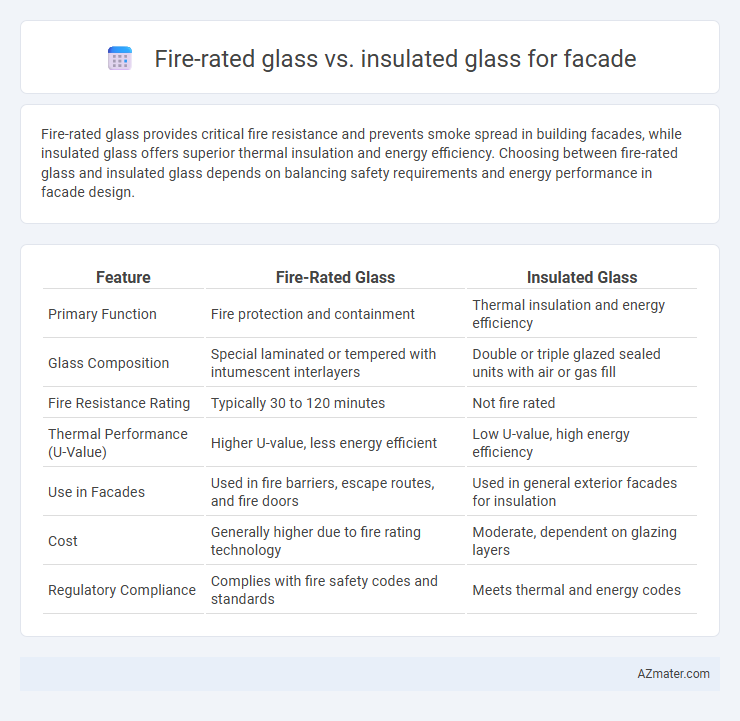Fire-rated glass provides critical fire resistance and prevents smoke spread in building facades, while insulated glass offers superior thermal insulation and energy efficiency. Choosing between fire-rated glass and insulated glass depends on balancing safety requirements and energy performance in facade design.
Table of Comparison
| Feature | Fire-Rated Glass | Insulated Glass |
|---|---|---|
| Primary Function | Fire protection and containment | Thermal insulation and energy efficiency |
| Glass Composition | Special laminated or tempered with intumescent interlayers | Double or triple glazed sealed units with air or gas fill |
| Fire Resistance Rating | Typically 30 to 120 minutes | Not fire rated |
| Thermal Performance (U-Value) | Higher U-value, less energy efficient | Low U-value, high energy efficiency |
| Use in Facades | Used in fire barriers, escape routes, and fire doors | Used in general exterior facades for insulation |
| Cost | Generally higher due to fire rating technology | Moderate, dependent on glazing layers |
| Regulatory Compliance | Complies with fire safety codes and standards | Meets thermal and energy codes |
Understanding Fire-Rated Glass: Key Features
Fire-rated glass for facades offers essential fire resistance by slowing heat transfer and blocking flames, typically rated from 20 to 120 minutes. It features specialized interlayers or ceramic coatings that maintain structural integrity under high temperatures, preventing fire spread while allowing visibility. Unlike insulated glass, fire-rated glass prioritizes safety and compliance with building codes over thermal insulation performance.
Insulated Glass: Structure and Thermal Benefits
Insulated glass for facades typically consists of two or more glass panes separated by a spacer filled with inert gas, enhancing its thermal insulation properties by reducing heat transfer and improving energy efficiency. The airtight seal and low-emissivity coatings on the glass minimize heat loss in winter and reduce heat gain in summer, maintaining consistent indoor temperatures. These features make insulated glass an ideal choice for sustainable building design, contributing significantly to energy savings and occupant comfort.
Fire Resistance vs. Thermal Insulation: Core Differences
Fire-rated glass offers superior fire resistance by withstanding high temperatures and preventing flame and smoke spread for a specified duration, making it essential for safety in building facades. Insulated glass focuses on thermal insulation, reducing heat transfer and enhancing energy efficiency with multiple glass layers separated by air or gas-filled cavities. The core difference lies in fire-rated glass prioritizing fire safety performance, while insulated glass emphasizes energy conservation and temperature control.
Safety and Building Code Compliance
Fire-rated glass offers superior fire resistance by preventing heat and flames from penetrating, ensuring occupant safety during emergencies and complying with stringent building codes like NFPA 80 and ASTM E119. Insulated glass primarily enhances thermal performance and energy efficiency but does not provide the same level of fire protection required for fire-rated assemblies. Choosing fire-rated glass for facades is crucial in meeting safety regulations and achieving code compliance in high-risk or commercial building applications.
Energy Efficiency Considerations
Fire-rated glass offers essential safety by withstanding high temperatures during fire incidents but generally has lower thermal insulation compared to insulated glass, which is engineered to reduce heat transfer and improve energy efficiency. Insulated glass units (IGUs) utilize double or triple glazing with gas fills and low-emissivity coatings to minimize heat loss and solar heat gain, significantly enhancing building facade energy performance. Selecting insulated glass for facades supports compliance with energy codes and reduces HVAC loads, whereas fire-rated glass primarily addresses safety without providing significant energy savings.
Aesthetic and Design Flexibility
Fire-rated glass offers enhanced safety with its ability to withstand high temperatures, making it ideal for facades requiring stringent fire protection without compromising transparency. Insulated glass enhances thermal performance and energy efficiency, providing a clear, sleek appearance that supports diverse architectural styles. Both types offer varying degrees of design flexibility, with fire-rated glass allowing for specific thickness and framing options, while insulated glass enables larger, uninterrupted panels for minimalist aesthetics.
Acoustic Performance Comparison
Fire-rated glass for facades offers moderate acoustic insulation typically ranging between STC 30-35, designed primarily to resist high temperatures and prevent fire spread. Insulated glass units (IGUs), especially double or triple-glazed configurations, provide superior acoustic performance with STC ratings often exceeding 40 due to air or gas-filled cavities that dampen sound transmission. For facade applications prioritizing noise reduction alongside thermal efficiency, insulated glass generally outperforms fire-rated glass in reducing external noise intrusion.
Cost Implications and Budgeting
Fire-rated glass typically incurs higher costs than insulated glass due to specialized materials and stringent safety testing, impacting overall facade budgeting. Insulated glass offers better thermal performance at a lower price point, which can reduce long-term energy expenses but lacks fire resistance certifications. Project budgets must carefully balance upfront investment in fire-rated glass against potential savings and regulatory compliance achieved with insulated glass options.
Maintenance and Lifespan Factors
Fire-rated glass for facades offers exceptional durability with a typical lifespan of 20-30 years, requiring minimal maintenance focused on regular inspections for cracks or seal integrity. Insulated glass units (IGUs), designed primarily for thermal efficiency, generally last 15-25 years but demand more frequent seal repair or replacement to prevent condensation and maintain insulation performance. Maintenance of fire-rated glass prioritizes compliance with fire safety standards, while insulated glass maintenance centers on preserving energy efficiency and overall facade integrity.
Choosing the Right Glass for Your Facade
Fire-rated glass offers essential safety by withstanding high temperatures and preventing fire spread, making it ideal for facades requiring compliance with fire safety regulations. Insulated glass improves energy efficiency and thermal comfort by minimizing heat transfer, suitable for facades focused on sustainability and reducing HVAC costs. Choosing the right glass for your facade depends on balancing fire safety requirements and energy performance goals based on your building's design and local building codes.

Infographic: Fire-rated glass vs Insulated glass for Facade
 azmater.com
azmater.com